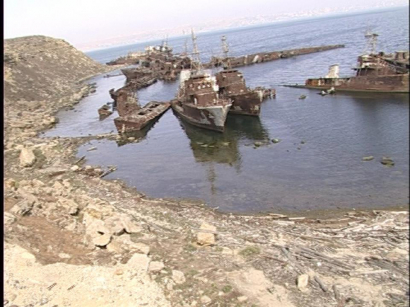An Island Blanketed In Fog

It was a cold winter morning of February 1915. Khazri (the cold north Caspian Sea wind) that was raving through the night quieted down by morning. The dawning light secretively set over the dancing water in the Baku Bay. Although the city just was up, the port did not get a wink of sleep overnight. Hand trucks were continuously loaded and unloaded, vessels full of heavy loads were bound outwards, giving place to pending vessels in the port.
A gaiety envelopes in front of a big vessel tied up at port. Carted goods are unloaded and put into the vessel. The man managing the process hastens the porters.
A phaeton approaches the load platform. On seeing the phaeton, the policemen walking along the shore are standing at attention to salute. A middle-aged woman is sitting at the back doorstep of the phaeton. The woman, sheltering from the wind and ensconcing her behind a short fur coat is known not only in the port, but citywide. Sona khanym Hajiyeva - the spouse of Kerbalayi Israfil Hajiyev, a noble proprietor and member of the Duma - owns a very expensive vessel. Sona khanym is known citywide as a smart and grand lady, and a great patriot. She, as Chair of the Muslim Women's Charity, provides financial assistance to needy persons, makes donations to build schools for poor children, and calls wealthy people of the city to collect money for charity.
Background: Boyuk Zira, located 10.5 kilometres off the Bay of Baku, is an island in the Caspian Sea. It has a length of 3.1 km, and a width of 900 m. The northwestern side of the island is vertical and steep. A beacon in the island began to function on December 11, 1884. In 1941, because of the beginning of the Great Patriotic War, the building of the beacon was blown up by order of the Soviet Military Command. Anti - aircraft guns were established on the island to defend Baku from German air raids, because the building of the beacon was a potential landmark for German aviators. The beacon was restored in 1958. An 18m stone tower equipped with a complex optical-navigational system, was built in the elevated middle part of the island.
Boyuk Zira was also called Nargin, which is related to the name of Peter the Great in 1719. The shape of these islands reminded the Russian emperor of Revelian islands with analogous names in the Gulf of Finland, after a war with Swedes. German "Nargin" and Estonian "Nartingen" mean a "narrow strait". In 1991, Nargin Island has been returned its indigenous name. Nargin Island hosted tragic events in the history of Azerbaijan. Thousands of soldiers, as well as civilians, who were captured during World War I in Turkey during the occupation of Eastern Anatolia by the Russian army, were in captivity on the island.
According to historical facts, most of the Turkish POWs on the island died of starvation, thirst, snake bites, or bullets fired by Armenian traitors. The facts show how heinously the Turkish prisoners of war were tortured by Armenian soldiers and officers who served in the Russian army at that time. According to some sources, about 10 thousand of Turkish soldiers were killed on the island. And some representatives of the intelligentsia were also brought and killed here during repressions of 1937-1938.
Turkey initially did not want to enter World War I. However, it was driven into this alliance after a series of negotiations with the Central Powers, particularly with Germany. In December 1914, the Turks fought the Caucasian Front. As a result of combat actions on the Caucasian front Turkish soldiers who fought in Sarykamysh, Kars, Igdir, Erzurum, Ardahan, Trabzon, and other cities were captured by Russians, giving no quarter to old, children, and patients. The Turkish prisoners of war from Anadolu were dispatched to prisoner camps in 22 regions of Russia, including the Nargin Island.
AND OTHER...
-
 Book “Fuzuli’s Creativity” by Mir Jalal Out in Jordan
Book “Fuzuli’s Creativity” by Mir Jalal Out in Jordan
The book “Fuzuli’s Creativity” by the famous Azerbaijani writer and literary scholar Mir Jalal, which tells about the works of the brilliant Azerbaijani poet...
-
 Yusif Vazir Chamanzaminli’s Creativity in the Israeli Literary Magazine
Yusif Vazir Chamanzaminli’s Creativity in the Israeli Literary Magazine
“Artikl”, the popular Israeli literary magazine, has posted in Russian an excerpt from the novel “In the Crossfire” by Yusif Vazir Chamanzaminli, the outstanding...









